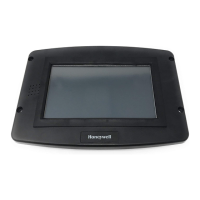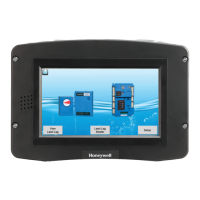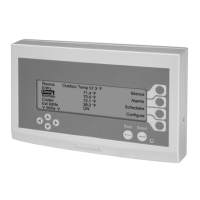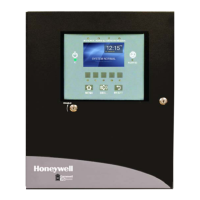11 65-0315—02
An alert log can be displayed for each control by pressing the
Alert button on the bottom of the history status page. A
description of the alert is displayed along with the time when
the alert occurred (see Table 3).
History Button
The History button on the Home page serves not only as a
button, but also displays Sola Control lockouts, holds, and
alerts as they occur. The History button can be selected at
any time, regardless of which type of information is displayed,
to view history information. Pressing the History button
displays a dialog box (see Fig. 20) that allows the user to
select the type of history to view. The user can also silence an
audible alarm generated by the control during a lockout or
alert by alarm condition.
This History dialog box provides an exploded view of the
status information displayed in the History button (the font is
larger). One of the four buttons (OK, Lockouts, Alerts, or
Silence) can be selected. If none of these buttons are selected
the dialog box closes after 30 seconds.
Fig. 20. Hydronic history example shown—exploded view.
Two types of historical data can be displayed on the history
page: lockout history and alert log.
The entire 15 fault code history is displayed in a scrollable list
with the most recent fault displayed first followed by the next
most recent fault (see Fig. 21). Summary information is
displayed for each fault entry, including the burner cycle count,
fault code, and fault number with description. Detailed
information for a specific fault entry that also includes burner
control sequence state, burner run-time hours, annunciation
status, etc., is viewed by selecting (touching the History line)
the lockout entry in the list (see “Fault/Alarm Handling” on
page 10 for details).
Fig. 21. Lockout history example shown.
The date and time that each fault occurred is displayed in the
lockout history. The lockout timestamp displays in both the
lockout summary and detail information.
The Sola Control does not maintain date or time of day
information. The date and time stamp is assigned by the OI
display. When the OI display first obtains the lockout and alert
history from the control (during the display data
synchronization), no timestamps are assigned since the times
that the lockouts occurred are unknown. All new lockouts that
occur after the synchronization are assigned timestamps
when the lockout occurred.
NOTE: The system time can be set in the OI display to
ensure that correct timestamps are given to the
controls’ lockouts and alerts.
Table 2. Sola Control Lockout History.
Data Comment
Lockout time Set by display
Fault code Unique code defining which
lockout occurred.
Annunciator first out First interlock in limit string
results in a shutdown.
Description Fault description
Burner Lockout/Hold Source/reason for lockout/
hold
Burner control state
Sequence time Burner control state timer at
time of fault
Cycle Burner control cycle
Run Hours Burner control hours
I/O All digital I/O status at time of
fault
Annunciator 1-8 states All annunciator I/O status at
time of fault
Fault data Fault dependent data
Table 3. Sola Control Alert Log.
Data Comment
Alert time Set by display
Alert code Unique code defining which
fault occurred.
Description Alert description

